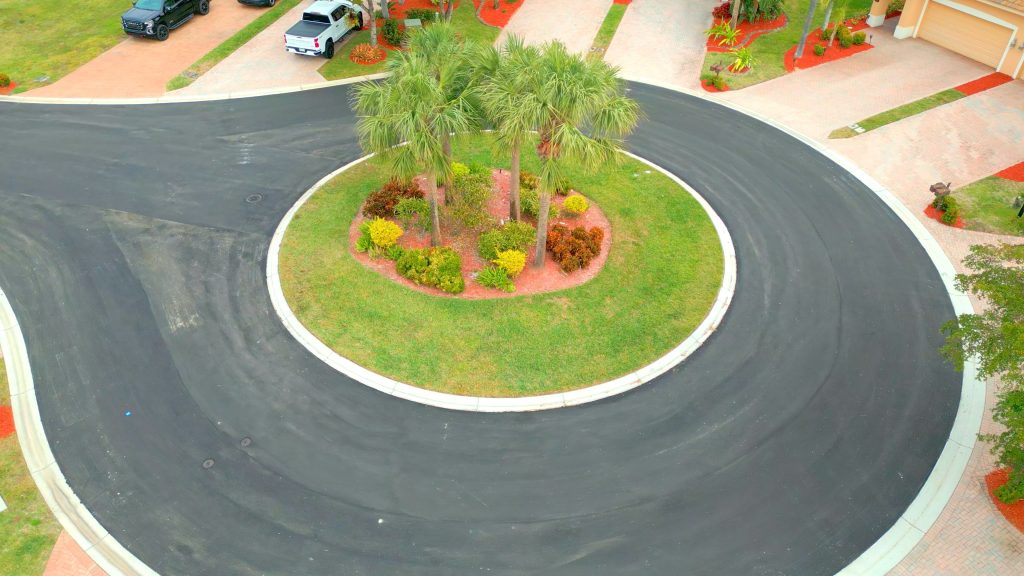Asphalt overlays are a popular choice for extending the life of commercial pavement without the cost of a full replacement. But one critical decision often overlooked is choosing between a thin overlay and a thick overlay. The thickness of your overlay can significantly affect performance, longevity, and overall return on investment—especially in a commercial setting.
In this guide, we’ll walk through what defines a thin versus thick overlay, when each is appropriate, and how to choose the right option for your commercial paving project.
What Is a Commercial Asphalt Overlay?
An asphalt overlay is the process of placing a new layer of asphalt over an existing surface. It’s commonly used on commercial properties to restore ride quality, improve appearance, and reinforce structural integrity without tearing out the full pavement system.
Overlays can be thin (typically 1″ to 1.5″) or thick (2″ to 3″+) depending on the surface condition and the demands of the property.
Thin Overlays: Fast, Cost-Effective Surface Refresh
Best for:
- Commercial parking lots with minimal surface wear
- Light traffic areas
- Situations where cost or timing is a priority
Thin overlays are typically used when the existing pavement is in decent shape but needs a surface refresh. This method smooths out small imperfections, enhances curb appeal, and adds minor reinforcement without a major investment.
Pros:
- Lower material and labor costs
- Faster application and cure time
- Minimal disruption to business operations
Cons:
- Not ideal for heavy traffic or deep structural damage
- Shorter lifespan (5–7 years on average)
- Less flexibility in correcting grading or drainage issues
Thick Overlays: Durable, Long-Term Performance
Best for:
- Heavily trafficked commercial drive lanes, loading zones, and industrial lots
- Surfaces with moderate wear or base layer instability
- Properties requiring long-term durability
Thick overlays provide enhanced structural support by adding more material. They are better suited for commercial environments where the pavement must endure consistent truck or vehicle traffic.
Pros:
- Increased load-bearing capacity
- Longer lifespan (10–15 years with maintenance)
- More effective in addressing uneven surfaces and minor base issues
Cons:
- Higher cost and more materials required
- May require milling to maintain proper height and drainage
- Longer installation time
Choosing the Right Overlay Thickness for Commercial Properties
The right overlay thickness depends on several factors:
1. Pavement Condition
Thin overlays are only viable if the existing pavement is in relatively good shape. If there are cracks, ruts, or signs of base failure, a thicker overlay (or even a mill & overlay) is likely the better option.
2. Traffic Volume and Load
For lots that see frequent heavy vehicle traffic—think delivery areas, industrial parks, or multi-tenant shopping centers—a thicker overlay is essential to prevent rapid deterioration.
3. Height Constraints
Thicker overlays can raise surface elevation. If your lot has fixed structures like curbs, loading docks, or ADA-compliant ramps, milling may be needed beforehand to avoid drainage or compliance issues.
Read more: Commercial Standard Overlay vs. Mill & Overlay: Key Differences
Cost vs. Longevity: The Tradeoff
While thin overlays may offer immediate cost savings, they generally require more frequent maintenance or earlier replacement—especially in demanding commercial environments. Thick overlays involve more upfront investment but tend to pay off with fewer repairs and longer-lasting performance.
Consult with a Commercial Paving Expert
Every property is different, and so is every overlay project. At The Pavement Group, we tailor our approach to your specific pavement condition, usage demands, and long-term goals. Whether you’re considering a thin overlay for light-use areas or a thick overlay for high-traffic zones, our team can guide you through the right decision.
👉 Contact us today for a free site evaluation and expert recommendation.


